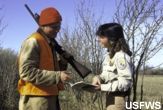Turkey Hunters Become the Hunted

A new study of deaths and injuries among wild game hunters in Pennsylvania found turkey shooters get shot the most. The reason is simple: They hide in bushes wearing camouflage clothing, calling for turkeys. Other hunters, fooled by the fake calls, stalk their fellow hunters and then blindly shoot into the bushes.
The study, reported in the Journal of Trauma, was announced today.
Scientists reviewed 1,382 hunting-related injuries and 77 fatalities in the state between 1987 and 1999.
For every 100,000 turkey hunters, 7.5 were injured. Grouse hunters had the lowest rate, of 1.9 per 100,000.
Deer hunters, however, suffered the highest death rate in relation to injuries. Among deer hunters who were injured, 10.3 percent died, owing mostly to the fact that deer hunters use rifles, while bird hunters use shotguns, which become less potent across just a few dozen yards.
Turkey hunters try to lure their game within 50 yards or less by mimicking the birds' gobbles. In violation of hunting regulations, other turkey hunters may stalk the turkey-like sounds, the study concluded.
"The stalking hunter then shoots toward the sound, mistakenly shooting the victim, the researchers write. "Approximately 75 percent of turkey incidents appear to have occurred in this manner."
Sign up for the Live Science daily newsletter now
Get the world’s most fascinating discoveries delivered straight to your inbox.
The fix seems simple.
Between 1992 and 1994, Pennsylvania required turkey hunters to wear fluorescent orange clothing. Injuries were lower for those years, the study found. But the regulation was relaxed, and hunters can now display the orange stuff 15 feet from their hiding spot.
Hunters claim the orange garb kills the hunt. Statistics suggest otherwise. Prior to the clothing regulations, only one turkey was put on the dinner table for every eight to 24 hunters, according to Pennsylvania Game Commission's data. Outfitted in orange, turkey fatalities climbed to one for every five to eight hunters.
Changes are likely.
"Because we constantly strive for zero hunting-related shooting injuries, we were an active partner in this study," said Keith Snyder, Pennsylvania Game Commission Hunter-Trapper Education Division chief. "We are already implementing some of the suggestions to better our hunter education efforts."
Gene Lengerich, a Penn State researcher who worked on the study, said more training should be provided to young hunters, particularly to improve judgment. And orange should come back into fashion this fall, he said.
Robert is an independent health and science journalist and writer based in Phoenix, Arizona. He is a former editor-in-chief of Live Science with over 20 years of experience as a reporter and editor. He has worked on websites such as Space.com and Tom's Guide, and is a contributor on Medium, covering how we age and how to optimize the mind and body through time. He has a journalism degree from Humboldt State University in California.











